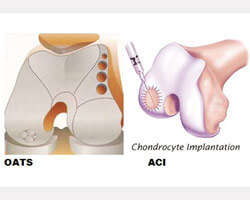Cartilage Injuries
Damaged Articular cartilage which was till now consideredirreparable can now be repaired with new advances in arthroscopicsurgery procedures. Mosaicplasty is a technique where healthycartilage from non-weight bearing portion of the joint istransferred to damaged portion of the joint with the help of specialized instruments.
Autologous Chondrocyte Implantation( ACI) is atechnique where cartilage cell is taken from the joint and cultured in specialized laboratories and the cultured cartilage is thenimplanted over the damaged portion of the joint.

FAQs by Cartilage Injuries Patients
What are the most common cartilage injuries?
Cartilage injuries are a common occurrence, especially in athletes and individuals who engage in repetitive or high-impact activities. The most prevalent cartilage injuries include osteoarthritis, meniscus tears, and chondromalacia patellae. Osteoarthritis is a degenerative condition that affects the cartilage in joints, leading to pain, stiffness, and reduced mobility. Meniscus tears, on the other hand, occur when the C-shaped cartilage discs in the knee joint tear due to sudden twisting or direct impact.
What are cartilage injuries examples?
This injury can cause pain, swelling, and limited range of motion. Chondromalacia patellae, also known as runner’s knee, is a condition where the cartilage on the underside of the kneecap becomes soft and damaged. It often results from overuse, muscle imbalances, or poor alignment of the kneecap. Symptoms include pain, a grinding sensation, and swelling around the knee. These common cartilage injuries can significantly impact an individual’s quality of life,
requiring proper diagnosis, treatment, and rehabilitation to restore joint function and alleviate pain.
Can damaged cartilage heal itself?
Cartilage, a vital connective tissue for joint support and cushioning, has limited self-healing ability due to its lack of direct blood supply. Injury or conditions like osteoarthritis pose challenges for effective repair. Recent medical advancements offer hope in cartilage regeneration through techniques like tissue engineering and stem cell therapy.
Tissue engineering involves creating artificial cartilage using cells, scaffolds, and growth factors, while stem cell therapy harnesses the regenerative potential of stem cells. However, these approaches are still under research and
refinement, and individual factors can influence the healing process. Seeking professional medical advice and treatment is crucial for managing cartilage injuries and promoting optimal healing.
How long does cartilage damage take to heal?
Cartilage damage commonly occurs in areas like the knee, shoulder, or hip. Healing time varies based on injury severity and individual health. Cartilage has limited self-repair ability due to lack of direct blood supply. Minor damage may heal in weeks to months, while major injuries may require longer and more intensive treatment. Factors like age, overall health, and rehabilitation adherence also affect healing time. Younger individuals heal better due to higher metabolic rate. A healthy lifestyle aids healing. Each case is unique.
